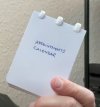Lucas W.
Registered
I often find my self trying to put everything into my GTD – but of course a lot of “things” do not fit (but I am not alone – a lot of people do the same with MS Excel).
For instance there are some repetitive tasks which are nice to do but there are no obligations.
So it might be welcome to take them out from your GTD and put them on your desk.

You can do this task if you want and then roll the page to the next one.
I have found this tip on “Flatability” YouTube channel and it looks quite smart (you can start at 12 min 40 sec):
https://www.youtube.com/watch?v=avCSP0_BDqc&ab_channel=Flatability
I wonder if you guys had any “things” intentionally taken out from your GTD?
For instance there are some repetitive tasks which are nice to do but there are no obligations.
So it might be welcome to take them out from your GTD and put them on your desk.

You can do this task if you want and then roll the page to the next one.
I have found this tip on “Flatability” YouTube channel and it looks quite smart (you can start at 12 min 40 sec):
https://www.youtube.com/watch?v=avCSP0_BDqc&ab_channel=Flatability
I wonder if you guys had any “things” intentionally taken out from your GTD?
